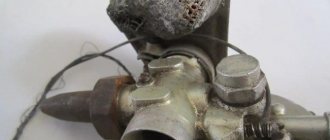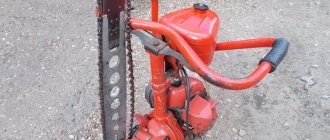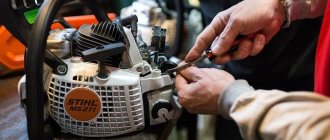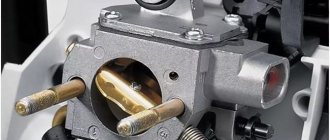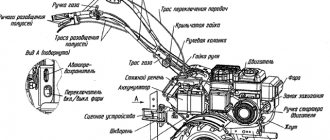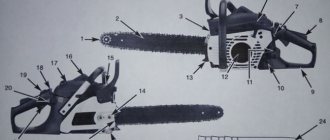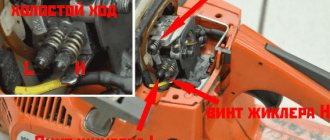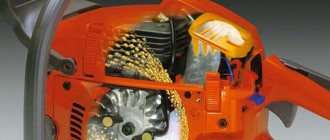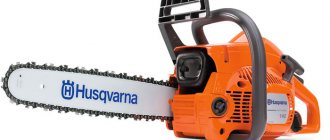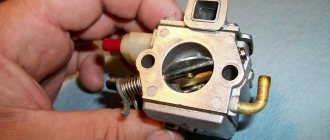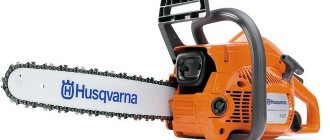A chainsaw is considered by many as an ideal and indispensable assistant. After all, with its help you can perform all the work that an ax previously helped to do, without spending a lot of effort and time. That is why almost every home craftsman has such a tool in his arsenal.
The design of the units in question is not that complicated. This means that every craftsman can repair the instrument, taking into account the advice of specialists. We will look at the sequence in which the Husqvarna 236 carburetor is adjusted with our own hands.
Carburetor components
First of all, it’s worth figuring out which adjustment screws are provided in the Husqvarna 236 chainsaw.
The manufacturer equipped the model in question with 3 screws:
- The L-screw adjusts the jet at low speeds;
- The H-screw adjusts the jet at higher speeds;
- The T-screw is used to adjust the idle speed.
If it is necessary to adjust the supply of fuel, lubricant mixture and air access, the first 2 elements are used. By turning them clockwise, the mixture can be leaner and the speed reduced. By performing the actions in the reverse order, that is, unscrewing the elements in the opposite direction, the mixture is enriched and the speed increases.
Idle speed is adjusted by the third element. By turning it clockwise, the speed increases, and to decrease it, simply turn the screw in the opposite direction.
Design and features of Husqvarna 236
The structure of the chainsaw is shown in the picture below:
The design of the Husqvarna 236 chainsaw ensures the comfort and safety of the operator. An emergency brake is provided to quickly stop the mechanism. There is also a system for catching a chain that has fallen off, which protects against accidental injuries during work. The air purification system is centrifugal and promotes efficient cooling. Vibration protection reduces the load on the operator and allows you to work for a long time without interruption. The fuel system is equipped taking into account environmental standards and additionally cleans exhaust gases from harmful compounds. Reducing fuel consumption was achieved using the Husqvarna 236 X-torq chainsaw equipment - an innovative system that reduces fuel consumption by 20%.
Step-by-step adjustment
Experts recommend that you independently adjust the carburetor in the model in question, adhering to the following plan:
- First of all, you need to adjust 1 screw, then proceed to the second and only lastly start adjusting the screw responsible for idle speed.
- Next, you need to determine what the highest idle speed is. To do this, you need to carefully turn 1 screw clockwise. Having found the largest indicator, the element should be turned ¼ turn counterclockwise. If during this operation the chain continues to rotate while idling, screw T must be slowly turned counterclockwise until the chain stops rotating.
- Using screw H for adjustment, you can actually change both the power of the unit and its speed. However, it is worth keeping in mind that if the carburetor operates for a long time using the usual mixture and at high speeds, this may cause the chainsaw to fail.
- To adjust screw H, you need to take the following steps:
- warm up the engine of the unit for 15-20 seconds, selecting full speed mode;
- turn the H-element counterclockwise ¼ turn;
- leave the engine running for 10-15 seconds;
- using a tachometer, analyze what the maximum speed is;
- If the received data does not match the passport data, the process should be repeated again.
The four-stroke sound of the engine will help you understand that the adjustment has been made correctly. If the mixture is too lean after adjustment, the unit will make a squealing sound. If the mixture is too rich, smoke will begin to appear from the muffler. If home craftsmen have a device called a tachometer in their arsenal, then you can begin to independently adjust the H-screw. In other circumstances, it is better to seek help from specialists.
- After the first elements have been adjusted, you can begin adjusting the idle speed screw, performing the operation in the following sequence:
- Having activated the engine, you should carefully begin to turn the screw T clockwise;
- it is necessary to rotate the element until the unit chain begins to rotate;
- at the next stage, the screw must be turned in the opposite direction to stop the rotating movements of the chain.
To understand that it was possible to correctly set the idle speed, uniform operation of the engine, in any direction, with the necessary reserve of revolutions, while the chain rotates, will help.
The above instructions for adjusting the Husqvarna 236 carburetor will greatly simplify the work. But if some stage still causes difficulties, everyone can find a hint by visiting an Internet resource and watching a video tutorial on this topic.
You can independently understand that the work was done correctly by the operation of the engine, which should accelerate instantly and make a four-stroke sound at full throttle. If the unit starts with difficulty and the engine cannot accelerate immediately, the first screw should be readjusted again to enrich the lean mixture.
A chainsaw is a tool that is useful in any country house, even for amateurs, not to mention professional workers. But, like any other device, a chainsaw needs constant care and prevention. One of the most common procedures is to adjust the carburetor of a chainsaw due to incorrect settings in the past.
The engine stalls when you press the gas: causes and solutions
This process may be based on:
- fuel filter clogged;
- depressurization of fuel hoses;
- muffler malfunction;
- jamming of the valve in the float chamber due to which the mixture does not flow in full;
- Air filter contamination;
- failure of the crankshaft seals.
Eliminating all the identified causes comes down to:
- cleaning working bodies associated with liquids or air working environment;
- external inspection of the listed parts for problems;
- replaced old parts with new ones.
Correct adjustment of the carburetor, which is quite feasible at home, plays an important role in stabilizing the working stroke of the Husqvarna chainsaw.
The first signs of a carburetor malfunction
Due to untimely or unprofessional periodic maintenance of the chainsaw, as well as due to heavy load, difficulties in its operation may arise from time to time. For professional workers, such breakdowns can reduce their work efficiency and spoil their mood for the whole day.
Carburetor malfunctions, in turn, have specific symptoms. Using them, you can immediately determine the cause of the breakdown.
The following signs indicate an incorrect carburetor setting:
Read also: Water level sensor operating principle
- The tool starts up problematically, after which it immediately stalls.
- The chainsaw stalls when you press the gas.
- Gasoline is consumed in large quantities, and it still remains in the cylinders and does not burn out completely, and the exhaust is excessively thick.
- The carburetor settings installed at the manufacturer's factory are lost due to improper use or self-adjustment.
- Debris has entered the air intake system. Because of this, she failed.
- Engine pistons are used up. In this case, adjusting the carburetor will only temporarily solve the problem.
In the event that dirt gets into the carburetor, one adjustment will not do. Here you just need to clean it. When the pistons are used up, a major overhaul of the engine is required.
But after this, of course, you need to adjust the carburetor jets, as well as purge and clean them.
Troubleshooting algorithm
In all other cases, the search for ignition problems begins from the end and in order. After each step, check the spark.
- Replace the old spark plug with a guaranteed working one.
- If the model has a removable spark plug cap, remove it, and the exposed spark plug wire is connected to ground with a gap similar to that of a spark plug. They pull the starter. If there is a spark, the problem is in the cap. She is being eliminated.
- Change the spark plug wire where it is possible to remove it from the source.
- Visually inspect the wires from the switch. Vibration or contact with metal can cause damage. If there are friction points, the wire is replaced, even if there is no external damage to the insulation. You can use a tester or multimeter to check the wire.
This is where minor and easily fixable problems end. If the problem is not solved, then the reason is more serious. Modern coils and ignition systems on most chainsaws are very reliable. They are designed to last even longer than the entire chainsaw as a whole. There are no mechanical moving parts like older cam systems. They are sufficiently insulated from clogging and moisture.
If, due to an accidental manufacturing defect, an interturn short circuit occurs in the coil or the electronics fail, these parts cannot be repaired. Will need to be replaced with new ones.
It is not uncommon for a mechanical failure to occur. Due to wear or destruction of the crankshaft bearing, play appears on it. And then the magnetic rotor begins to touch the body of the ignition system, inside which it rotates. This is a serious breakdown. You will need to “halve” (disassemble) the entire engine, replace the bearing, and put everything back in place.
Operating principle
The purpose of the carburetor is to prepare the working mixture for supplying it to the engine cylinders. This mixture is gasoline and air in the proportions required for engine operation. If this ratio is violated, the engine will not operate smoothly. When the mixture has a lot of gasoline, then in layman's terminology it is called saturated, and if, on the contrary, there is little, then it is lean. But in any case, a failure in the proportions of the working mixture will have a bad effect on performance.
Different models of chainsaws may have different carburetor designs, but according to the principle of operation they are all identical. Air moves through a special channel at a speed that can be adjusted by closing or opening the damper. Gasoline, in turn, enters the carburetor through jets and mixes with air there, creating a special mixture that enters the engine.
The pressure in the float compartment of the carburetor, where gasoline is present before mixing, is close to atmospheric. When the damper is opened, there is more air, as well as gasoline, due to which the engine speed increases. This creates a vacuum in the air channel and gasoline is drawn into the air flow. This is the principle of operation of a carburetor .
In order for the chainsaw to operate smoothly and efficiently, and also without high fuel consumption, its carburetor must be adjusted accordingly. Before such work, you must first check the air and gasoline filters. If dirt is found on them, they should be replaced.
Setting up a chainsaw for most models is usually done using three screws - high and low speed and idle speed.
The following signs should indicate correct configuration:
- The chain should not move at idle.
- The motor runs smoothly.
- There should also be no interruptions in work at start-up.
Repairing a chainsaw carburetor with your own hands must be done very carefully, because any mistake made can lead to serious consequences, even to the point of complete engine failure. If you do not have sufficient experience, then it is better to seek the help of a specialist .
Troubleshooting Tips
Fuel transfusion and filling of a chainsaw spark plug can be one-time and accidental. For example, “over-pumping” with a pump cap (primer): the engine does not start immediately, the operator presses his finger on the cap again and again, tries to start it, then pumps it up again.
In this case, the reason is not at all in the carburetor. You need to unscrew the spark plug and ventilate the combustion chamber by pulling the starter cord several times, as when starting. The candle is wiped, dried on the flame of a gas burner or burner, or another one is used. They check the spark, put the spark plug in place. They try to start it first without choke.
If it does not start after 3-4 jerks, press the pump cap 2-3 times. They try again. That is, after an overflow, it is better not to pump up the fuel first, but to pump it up incrementally. Until the engine starts.
Candles sometimes require their own maintenance and care.
- Inside, around the insulator, there should absolutely be no soot or dirt.
- The contact between the electrode and the plate from the spark plug body is cleaned with “zero” sandpaper. Carefully, without rounding the end of the electrode.
- You need to know the recommended spark plug gap indicated in the instructions for each chainsaw model (from 0.5 to 0.65 mm or more).
- To accurately adjust the spark plug gap, special feelers are used - a fan-shaped set of plates of different calibrated thicknesses, which fold into a handle like a folding knife. Sold in auto tool and spare parts stores.
- When working in winter, it is better to store the chainsaw at low temperatures. When taken out of the heat and into the cold, a sharp temperature change can cause condensation to form everywhere, including in the ignition system, and this is harmful.
One of the reasons for the lack of spark in a chainsaw is described in the following video, where they also talk about how to fix the breakdown:
Modern chainsaw ignition systems are quite compact and reliable. You just need to protect them from direct moisture, shock, and exposure to extreme temperatures. And then there will be no problems with the lack of spark during startup. Also, 1-2 spare spark plugs that are known to work will not be superfluous.
The main advantages of the Husqvarna 236 petrol saw are its durability, ease of everyday use and durability. The model has a high quality branded factory assembly and the ability to quickly and efficiently cut wood of any type. This makes the Swedish garden tool suitable not only for cleaning trees, but also for performing various tasks during construction and renovation.
Adjusting the Husqvarna chainsaw
During the break-in period of the Husqvarna chainsaw 142, 240, 236, 137 and other similar models, the carburetor settings are set in such a way that the engine speed is 600-700 less than normal operating speeds. If the operating frequency cannot be adjusted using the tachometer, it is not recommended to reset the factory settings using screw H.
The manufacturer strictly prohibits exceeding the working speed on your own. When, after adjusting the carburetor, the chainsaw chain moves at idle, then by turning screw T counterclockwise you need to stop it.
In order to accurately adjust the saw , it must be installed on a flat surface with the bar facing forward. You also need to warm up the engine for at least 12-15 minutes. First you need to determine the highest idle speed number. To do this, screw L in the chainsaw must be turned clockwise, and then in the opposite direction. After determining the desired frequency, the same screw is turned counterclockwise from 12 to 25% of its full revolution.
The idle speed in models from this manufacturer is adjusted using a jet with the letter T. The adjustment is made by turning it clockwise until the chain moves. After this, turn it easily counterclockwise until the chain stops moving.
The H screw of the chainsaw is adjusted correctly only when the saw does not make much noise when the gas is pressed all the way, and at the same time it is not weighed down by any load.
In the case when the saw is too noisy during operation and smokes, then this jet must be turned from left to right for adjustment.
Technical characteristics of the chainsaw
- Power – 1.9 hp;
- Gas tank – 300 ml;
- Carter - 0.2 l;
- Tire – 350 mm;
- Chain – 52 links with 3/8 pitch;
- Weight – 7.37 kg.
No particular shortcomings were found with this Husqvarna chainsaw. The issue that you will have to face is the high cost of the consumables and lubricants recommended for use.
Saws Shtil and Partner
In chainsaws Shtil 250, 361, as well as Partner 351, 350, the carburetor is adjusted using screws H and L by setting the proportions of gasoline and air. If you release them, a large part of the fuel will be added and therefore the speed will be high, otherwise, on the contrary, it will drop.
Read also: Silumin properties and applications
The idle speed in Partner chainsaws is regulated using a screw with the letter T, but with Shtil, as a rule, you need to look for the LA marking. Standard adjustment of the chainsaw is carried out during final tests. Basically, after such settings, the percentage of fuel in the working mixture is greater than air, which does not correspond to the optimal parameters. But they must be preserved during the first hours of operation during the running-in of the device. After this, the saw can be adjusted independently, but it will work well even at the factory settings.
But if you decide to regulate yourself, then the actions must be performed in the following sequence:
- adjusting screw L;
- then adjust the jet H;
- after that, proceed to adjusting the idle speed using screw T (if the Shtil chainsaw is LA).
First, screw L must be turned in both directions in order to find the maximum engine speed. If that point is found, then turn the same screw by ¼, thereby slowing down the speed a little. If the chain continues to move at idle, you must immediately turn screw T (LA) until the chain stops completely.
After setting the maximum speed with screw H, you need to check the frequency on the tachometer. In the event that it does not correspond to those specified in the service book, the setting must be repeated. When a lot of smoke comes out of the exhaust pipe at maximum speed, the mixture is too rich in fuel; if noise is heard and the engine gets very hot, then, on the contrary, it is lean. Then you need to adjust the idle speed. With proper settings, the engine should sound smooth at low speeds, and the chain should not move.
What to do if the chainsaw continues to not start?
If the initial inspection did not yield anything or the defects were eliminated during the search process, but the chainsaw still does not start, then you need to look for more serious reasons. It is best to identify and repair such breakdowns at a service center. However, if you have experience, you can find and eliminate them yourself. What to diagnose and check?
- Compression in the cylinder;
- Compression in the crankcase;
- Carburetor operation.
In the first case, checking the compression in the cylinder will allow you to find out the condition of the cylinder-piston group (CPG) of a chainsaw that does not want to start when cold. To do this you need a compression gauge. The device is screwed into place of the spark plug and the engine is started idle. Measuring the readings allows you to judge the condition of the CPG. In the absence of a compression gauge, you can determine the compression in the cylinder offhand as follows:
- Place your finger on the spark plug hole;
- Try to start the chainsaw engine.
By placing your finger on the spark plug hole and pulling the starter, you can check the compression in the cylinder
If you feel that your finger is being pulled strongly into the spark plug channel, then everything is in order with compression. The absence of vacuum in the chamber indicates a malfunction. The cylinder-piston group needs a more detailed inspection, which will give an idea of the condition of the piston and cylinder, piston rings and bearings.
A chainsaw may not start when cold due to a lack of compression in the engine crankcase. The main reason for this is damage to the gasket located between the cylinder and the crankcase. It is quite easy to detect a lack of compression:
- Disconnect the upper tube from the carburetor;
- Pour gasoline into a regular cork;
- We immerse the removed tube in the fuel;
- We pull the starter several times.
If fuel is sucked out of the cap when the chainsaw starter starts, then everything is fine with compression. If not, look at the gasket.
If the fuel is drawn in, then everything is fine - the gasket is intact. Otherwise, you will have to purchase a repair kit and make a replacement. How to do this, watch the video why a Chinese chainsaw won’t start:
Starting the tool may be complicated by improper operation of the carburetor or its breakdown. It often happens that during the sawing process the fastening screws become loose and air is sucked into the cylinder. Check that the carburetor is securely fastened. Inspect it for fuel leaks. There can be many reasons for the malfunction. It is possible to accurately determine the malfunction, eliminate it and fine-tune the carburetor only at a service center.
After going through a step-by-step troubleshooting of the chainsaw engine, you will be able to find the malfunction, fix it yourself and successfully start your working tool. Do not take on types of work that you are not confident in. Entrust troubleshooting and troubleshooting to specialists from the service center.
Every person who is familiar with gas-powered tools knows that sometimes the equipment works intermittently, or may stall at one point and not start again. There are many reasons why a chainsaw does not start; we will try to consider the most common of them.
Chinese models
Adjusting the carburetor of a Chinese chainsaw, for example, Carver, is carried out in almost the same way as factory models. There are the same three main adjustment screws L, N, T. Sometimes such models have the ability to adjust the idle speed. But as a rule, employees of specialized services and owners of such saws claim that it is not always possible to set up a high-quality Chinese chainsaw right away.
For classic Chinese models, screw L should be loosened 1.5 turns from the maximum value. Screw H must be loosened one revolution from the maximum. Idle speed is adjusted in the same way.
Thus, self-adjustment of a chainsaw carburetor is not a very complicated process and can, in most cases, be done by a self-taught person.
Adjusting the carburetor on a chainsaw in Husqvarna
Husqvarna 137 Carburetor Adjustment and Adjustment
In the picture above you can see three screws for adjustment. Each of them has its own purpose:
To adjust the idle speed, screw T is required.
Screw L is used to adjust low speed.
Screw H adjusts high speed.
Setting procedure:
First screw L (by rotating it), we look for the highest idle speed. Once we have found them, you need to turn this screw a quarter turn counterclockwise. If the chain continues to rotate in this position, then we turn screw T to stop it.
Then warm up the engine at full speed for 10-15 seconds and turn screw H a quarter counter to the hour. We wait 10 seconds and listen. The engine should run like a 4 stroke sound. If a squeal is heard, then the mixture is bad (we tighten the screw), if the rich mixture is smoky (tighten the screw).
After adjusting the low and high speed, set the idle speed using screw T. This is done as follows:
1. The engine must be running
2. Turn screw T clockwise until the chain starts to rotate.
3. Turn the screw to the other side until the chain stops.
Adjusting the carburetor with your own hands on a chainsaw
Adjusting the chainsaw carburetor ensures efficient operation of the tool at full power with economical fuel consumption. The adjustment should be made using a clean fuel and air filter. The adjustment is made with three screws: for maximum and minimum speed and idle speed.
Screws H and L regulate the mixture ratio of gasoline and air, determined by the opening of the carburetor throttle valve. When the screws are loosened, the mixture becomes richer, and the turns fall accordingly, when twisting, the mixture is depleted. revolutions increase.
Read also: Grit size of grinding wheels for wood
The designation H refers to the maximum speed screw, which controls the main jet, L. to the minimum speed screw, which controls the idle jet. Using screw S, the idle speed is precisely adjusted. Sometimes, to make adjustment easier, the number of available carburetor adjustment screws is reduced.
Setting the carburetor to two stages. basic (factory settings) performed with the engine turned off. and the finale, released with the engine running hot. The exact angular values should be taken from the operating instructions for the specific chainsaw. If the manufacturer's instructions are not followed, the engine may be damaged.
Husqvarna saw disassembly algorithm
The process of disassembling a Husqvarna chainsaw is quite simple. In order to do everything correctly and not break parts of the housing or CPG, it is necessary to disassemble in the following order:
- Top cover.
- Chain and saw brake cover.
- Starter.
- Flywheel and clutch.
- Front handle.
- Carburetor.
- Oil pump.
- Engine.
Depending on the Husqvarna model, the disassembly procedure may vary slightly.
Important: before you start disassembling the chainsaw, you need to clean it. When using a saw, a lot of chips and wood dust are generated, which during disassembly can get into the internal parts of the Husqvarna chainsaw.
Removing the side cover and saw set
The side cover, or also called the saw chain brake cover, is held in place with two thirteen nuts.
After unscrewing the nuts, the cover is removed from the guide pins, after which you can remove the bar and chain from the chainsaw. Some models of Husqvarna saws have a special mechanism installed that allows you to dismantle the cover and saw set without the help of special tools.
Starter
The starter is located on the right side of the Husqvarna and is held in place by several screws. By unscrewing them, you can easily remove the starter and thereby gain access to the flywheel and ignition coil.
Removing the flywheel and clutch
In order to unscrew the flywheel nut, you need to unscrew the spark plug and install a piston stopper in its place.
If you don’t have a special stopper, you can use an old cord from a chainsaw starter instead. It is necessary to tie knots on the lace at a distance of 2-3 cm, then, using a screwdriver, insert it through the spark plug hole inside the cylinder. The cord will limit the stroke of the piston, thereby preventing the crankshaft from turning and protecting the piston from damage.
Once the piston stopper is installed in the cylinder, the flywheel nut can be loosened. After the nut is unscrewed, it is necessary to use a hammer and a drift made of soft material to apply one sharp blow, installing the drift on the flywheel mounting shaft. This is necessary to remove the flywheel from the shaft, since the design provides for the installation and tightening of this element with great force.
You can learn more about how to properly remove the flywheel from a Husqvarna chainsaw, as well as how to completely disassemble the saw by watching the video. The wizard explains the entire process step by step and demonstrates all the necessary tools:
In order to unscrew the clutch you will need a special key. If there is no key, then it can be made from an old twenty-two head, grinding it in a certain way using emery.
The clutch has a left-hand thread and rotates clockwise.
Do not try to unscrew the clutch with a hammer and chisel, as some craftsmen advise. Using these tools, you risk breaking the clutch housing and increasing repair costs. It can also damage the crankshaft bearings.
Front handle
Removing the Husqvarna front handle is quite simple, as it is attached to the shock absorbers with screws.
Air filter and carburetor
To remove the carburetor, it is necessary to disconnect the fuel hose and damper rods from it; this can be done conveniently after the air filter is removed, which is installed immediately behind the carburetor and held in place with two 10mm nuts. After the air filter is removed, the fuel hose and the rods are disconnected, just pull the carburetor towards you and remove it from the studs.
Use tweezers and medical clamps to remove the carburetor.
Oil pump
On Husqvarna, the oil pump is installed on the right side of the chainsaw. It can only be removed after the clutch has been released. Removal does not require a special tool, because... The fastening screws are made for a regular Phillips screwdriver. After the screws are unscrewed, it is necessary to lift the pump and disconnect the oil hoses from it.
Engine
To remove the engine on a Husqvarna chainsaw, after the carburetor, clutch, flywheel and muffler have been removed, you will need to unscrew the four screws securing it to the body.
After the engine is removed, you can unscrew the ignition coil from it, remembering to first disconnect the wires leading from it to the ignition switch. The coil can also be removed immediately after the starter is removed.
Assembling the Husqvarna chainsaw should be carried out in the reverse order, and the flywheel nut and clutch must be tightened with the force specified in the chainsaw operating instructions.
Husqvarna 236 carburetor repair (repair kit replacement)
Replacing the carburetor repair kit on a Husqvarna 236 chainsaw
.
Basic carburetor adjustment.
The adjustment screws with maximum H and minimum rotation L are slowly turned clockwise until they stop, then they turn 2 turns, other settings are possible
Checking and adjusting idle speed.
We find the highest idle speed; to do this, slowly turn the screw L in different directions. After determining the maximum engine speed, turn screw L 1/4 turn counterclockwise. If the chain rotates at idle, turn screw T or (S) clockwise until it stops.
Check and adjust the maximum speed.
Changing the maximum number of revolutions is carried out by screw H. When it is tightened (clockwise rotation), the speed increases as you turn it. are decreasing. Chainsaw engines have a maximum rotation speed of 11,500 rpm. up to 15000 rpm. Higher speed does not provide ignition, in addition, it becomes dangerous for the engine. The maximum speed can be determined by interruptions in the ignition. If they come, screw H is turned slightly counterclockwise.
If the engine operation is not checked for acceleration and maximum speed, the chainsaw adjustment cannot be considered complete.
Related Posts
Do-it-yourself chainsaw carburetor adjustment
For an independent carburetor option, you need to familiarize yourself with its structure and understand the procedure for the work that is carried out to adjust the parts responsible for the proper functioning of the components of the device and parts close to it.
It is necessary to carefully handle items for the system option, and also to determine whether the set characteristics correspond to very acceptable values.
About the carburetor design
The carburetor serves to mix the flammable mixture with air while maintaining predetermined proportions. When is it necessary to adjust a chainsaw carburetor? Husqvarna 137. If precise doses are not followed, the proper functioning of the engine is at risk. Adjusting the Husqvarna 137 carburetor, like Husqvarna 240 or 260, will save a chainsaw. When a huge amount of air enters during mixing of the components, but there is not enough fuel, then such a mixture is considered “lean”.
Oversaturation should not be allowed, because with a larger amount of fuel compared to air, malfunctions or engine wear are also likely. Carburetor adjustment is needed not only before initial use, but also when any differences in its operation are detected. Before working with a chainsaw, do not forget to run it in.
Carburetor components
The carburetor design contains a standard set of parts, but may vary slightly depending on the manufacturer. Components:
- The basis . This is a special tube that is visually similar to an aerodynamic design. Air passes through it. In the transverse direction, a damper is located in the middle of the pipe. Its position can be changed. The more it is extended into the passage, the less air enters the engine.
- Diffuser . This is the constricted part of the tube. With its help, the air supply speed increases precisely in the segment from which the fuel comes out.
- Channels for fuel supply. The fuel mixture is contained in the float chamber, then passes into the nozzle, from which it flows into the atomizer.
- Float chamber . Adjusting the carburetor Husqvarna 236. Adjusting the carburetor with your own hands;. It is a separate structural element, reminiscent of the shape of a tank. Designed to constantly maintain the optimal level of fuel fluid before entering the channel from which air enters.
Don't know which chainsaw to choose? Read our article.
Are you looking for cheaper models, but reliable and time-tested? Pay attention to Russian-made chainsaws.
Or explore foreign chainsaw manufacturers such as Shtil.
What you need to have for setup
Each carburetor owner must have the necessary tools to adjust this system. The design of a chainsaw carburetor, adjusting the calm carburetor with your own hands. There are three adjustment screws that are located on the body of the device. They have their own markings:
- L - screw for correcting low speeds.
- H - screw for adjusting high speed.
- T - regulates idle speed, in most cases used for experiments.
